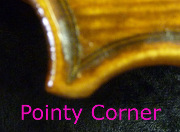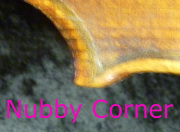Master Hand Violin Shop
Store Hours
<
Owner
Elizabeth Ecklund
Elizabeth Ecklund
We’ve heard all about it because it seems to have happened to everyone; you’ve just inherited a violin from your fiddler grandfather, and you want to know if the instrument is valuable or if it should just be left at the curb. You also happen to be busy and aren’t sure if it’s really worth the effort to squeeze a trip to Master Hand Violin Shop into your crazy schedule. Obviously, we can’t give you an instrument appraisal over the phone, but we can give you a few tips on what to look for to see if a violin (or viola or cello or bass) might be nice and worth keeping. Keep in mind that these tips are just tips and not surefire answers to replace an in person evaluation.
Things to Examine:
*Purfling -- Purfling is the (usually) black and neutral decorative inlay around the edge of the violin and is usually the most obvious giveaway of a cheap instrument. Purfling is tedious to put in, so if it is missing or painted on, the instrument is probably not very valuable. If it is neatly and tightly inlaid, that is a good sign. The style of purfling does vary somewhat from country to country and maker to maker, so its exact look is not always a definitive feature.
*The scroll -- One almost universal sign that a violin is nice is a well carved scroll. To determine if the scroll is carved out entirely, you should look at the part of the scroll that curves in towards the pegbox. Does the fluting continue making it carved all the way out or do the grooves disappear? Look at the scroll straight on. Is it crooked? Does it have blunt areas or does it look artistic? While the quality of the scroll carving does not affect the sound of the instrument, better factories and makers made a point of paying attention to this detail.

*Corners -- Like purfling, nice corners can have substantial variation in look based on maker and country of origin; some angles are sharper than others and some sit differently from others. However, all nice violin corners are well defined, carved out, and squared off. They do not look like nubs.


*Graduation of the wood -- Look at the top wood from the side. Does it get thicker and thinner or does it stay even? Even wood equals better craftsmanship, better sound resonance and consequently, a nicer instrument.
*The back -- In this beginners guide, we don’t expect you to be an expert at telling wood quality, so just look at the back of the violin. Is it plain wood or is it striped? Striped wood is better wood and indicative of a nicer violin.

*Inside of the violin -- Casually look around the inside of the violin. Are there any rough spots? Rough patches inside the instrument tend to indicate a poor quality instrument.
Things not to examine:
*Crud on the violin -- It’s a challenge because most old violins look bad. They can be covered with black crud that is so thick that you can barely see the wood. Don’t be fooled. Even very sticky crud can be wiped away.
*Missing pieces -- Old instrument glue frequently dries out and pieces of the instrument, such as fingerboards, nuts, and saddles can fall off. You may hear the sound post rolling around inside the violin. Don’t be deterred; these can easily be set up again.
*Cracks and seam openings -- As with missing pieces, glue can dry out in the seams, causing seam openings. Temperature and humidity changes may cause the instrument to crack. These can often be easily glued up.
Hopefully you see something nice on your instrument and are eager to bring it in. But even if not, at the end of the day, we never recommend throwing out a violin before having it evaluated by a professional. More than likely, if you didn’t know that your grandfather had a nice violin, and the purfling, scroll, corners, insides, graduation, and wood are poor, then the violin is quite cheap. There is probably no rush to get it into our shop. But you can never be 100% positive with these hints (especially if taken individually); we happen to have a six-figure violin with purfling painted on by one very lazy Mr. Paolo Antonio Testore.
Share on Facebook